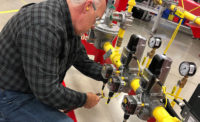Why my role exists, to me, is that it is simply for the people. The people I get to work with and for each day. When it’s about names, not numbers, there is a True North that continues to direct my vision of what World Class truly looks like. A vision that is committed around Zero beyond the number -- Zero families impacted.
Organizations that chase “zero” do not fully understand the value/meaning behind what EHS leaders are truly trying to instill in their organizational culture. The meaning behind what “zero” does for organizations is the people/names. These are mothers, fathers, brothers, sisters etc.
We, as leaders in the EHS profession, must continue to evolve. Organizations too often get stuck in a path that can foster teams that are not willing to take risks within the decision-making process, due to the chance of failure. If there is a chance of failure, there is a chance of success. As professionals, we must embrace the failures, as that is where learning occurs at the highest rates.
Numbers don’t define value
The reality is most things go right most of the time. The difference is how we take safety to another level within the business. It needs to be part of why there is a business; not a consequence of doing business. Business must embrace empathy within the safety culture. Number(s) and/or metrics do not define what the value of a safe workplace/culture is for an organization.
Just like business, safety should be lead — not manage. Some organizations do better with this than others. These are the organizations that have the ability, due to leadership, to go from good to great. They are truly committed to the value of what zero means throughout the organization.
Safety is not an aspirational target for organizations. It’s easy to say we are doing what’s right for our people. In reality, one cannot state publicly they do not care about safety. I’m not naive to think this does not happen today, but ethically and morally you have to lead by example. True North Safety is getting the level you demonstrate. It’s personal and has to be driven by names. How we learn from the mistakes/risk is what can define us as professional leaders.
Incidents are interactions
You cannot simply measure safety by a metric or single event. In all incidents there is an equipment element, behavior element and what most people fail to do is look at the catalyst(s). These are the outside contributors to the incident. Looking at “what the employee did wrong” is the easy thing to do. Why not look at what factors contributed to the interaction causing the incident? This takes much more critical thinking and time. Many times organizations do not want to know what is wrong because the information forces decisions to be made. This can make some managers uncomfortable.
The organizations that make it from good to great are the ones that are able to create/sustain culture to levels that are Safe Enough for Our Families. Safety should not be difficult. It should not be difficult to not hurt our families. In our society today there are a great many things that are complicated; safety should not be one of them. This is not a one size fits all mentality and it is not easy. It is a journey. Understanding that the journey takes time is critical to success.




